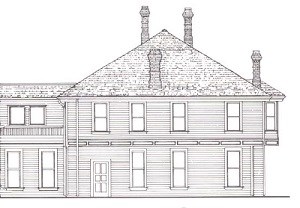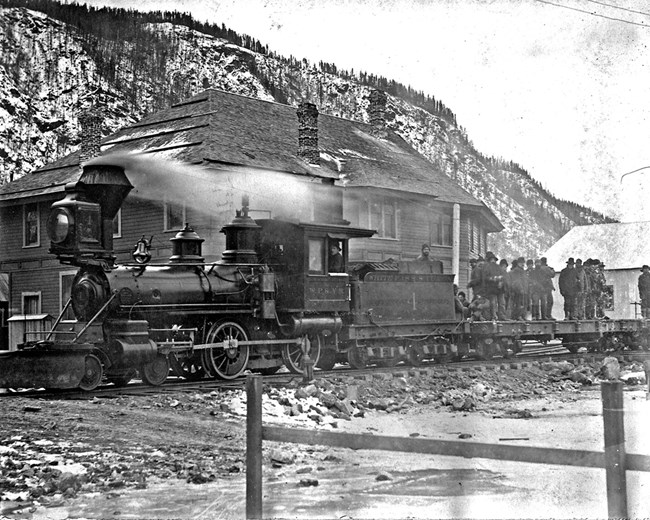
NPS photo 
NPS image Construction Begins
Construction of the White Pass & Yukon Route railroad began on May 27, 1898. Exactly when the new depot building was begun is unknown but it was probably staked out if not actually under construction soon after the Skagway City Council granted a right-of-way to the railroad company for tracks on Broadway.This was done Tuesday evening, June 14, 1898. Construction on the new line began at 7 am the next morning (June 15), and by that evening, a mile of grade had been prepared, ties laid and rail spiked. Mike Heney's Pacific Contract Company, the same firm building the railroad, probably also built the depot.The first published reference to the new depot was a brief mention about it being under construction in the November 18, 1898 issue of the Skagway News. Probably designed by a railroad civil engineer, the depot is an example of expedience in design, use of materials, and construction.It is basically a five-sided building, rectangular in plan except that the southwest corner of the building has been "clipped' because the main track of the railroad curved up past the depot in that location. The bay windows on the second floor of the Broadway side of the building were intended to be used for the dispatcher so that he could keep an eye on the approaching and departing trains. 
National Park Service, Klondike Gold Rush National, George and Edna Rapuzzi Collection, KLGO 55846. Gift of the Rasmuson Foundation. Open for Business
The Broadway Depot opened for business in December 1898 although its interior was not quite fully finished. The Skagway News (December 9, 1898) reported that Superintendent McCartney moved into his new office on the second floor while the "…new building is rapidly nearing completion…" At that time, however, and for some time afterwards, the rough board interior walls of the depot remained unfinished.This is evident by graffiti found in the stairwell and other locations. Workmen or visitors penciled names, dates, and figures on them, such as "Skaguay, Alaska / July 31, 1898," "John Ryand / March 3, 99 / No. 3101," and "Heney" (name of the chief builder of the railroad), followed by an obscene comment. As noted above, Mike Heney was the construction contractor who built the railroad, and there was a brief but bitter laborers' strike during the time the building was under construction that might account for the comment. In addition, two bulletins, one dated "Jan. 27, 1899," were pasted over the rough boards above the wainscoting in the waiting room. It is also apparent that wood was in short supply during the construction of the depot because the interior walls were pieced together with whatever lumber was available. For example, planks salvaged from stout packing crates, complete with stenciled designations of consignor and consignee, were used."From / Wm. Volker &Co. / Seattle, Wash." and "Lewis Cowley Co." are some of the stenciled names found on the depot walls during the building's restoration.This was all to change when the Daily Alaskan for April 28, 1899, reported that the waiting room "…in a few days will be painted and papered." Once the waiting room's interior was finished with paint and paper, it was described by another article in the Daily Alaskan as a "green and gold symphony…" The Skagway city directory for 1899 noted that "The building throughout is lighted with electricity and the traveling public will find it a pleasure to while away the time in these cozy waiting rooms. No passenger depot in Seattle or Tacoma can compare with it in appearance, convenience or elegance, and it is the most modern equipped passenger station north of Portland."
The depot must have been a rather crowded place during its first years of use, for it housed the General Offices in addition to the Operation Department of a railroad still under construction. Offices for the General Manager, Assistant Chief Engineer, and Chief Clerk as well as the Superintendent, Assistant Superintendent, and Dispatcher were all on the second floor and the ticket office, waiting room, and baggage room were on the first. For a time the Canadian Custom agents may have rented office space in the depot on the first floor, as did the U. S. Custom and Immigration Service. After the completion of the adjacent Railroad Administrative Building, in 1900, the officers of the railroad and the auditor department, which had been based out of Seattle before, moved over to the new administrative building while the upper floor of the depot was given over to the operation department. At the same time, the depot was remodeled slightly. A connecting enclosed bridge was built between the second story of the office building and second story of the depot which necessitated cutting a room in the depot in half to provide a hallway to the "bridge" connecting the two buildings. Two additional connections were subsequently built between the two buildings on the ground floor. In 1908 the baggage room of the depot was connected with the express room in the back of the ground floor of the office building.In 1922 a second addition was built to connect the east side of the waiting room with the northwest downstairs office of the railroad building. Another alternation involved cutting back the eves of the building in 1907, probably to admit more light to upstairs offices.
The Depot During World War II
In 1942 the United States Army 770th Railway Operating Battalion leased the railroad, including this building and began ferrying men, supplies, and equipment to Whitehorse for the construction of the Alcan Highway and Canol Oil Pipeline projects. This was another period in the building's history when it was again overcrowded, with army personnel working in addition to the railroad's personnel, and a dozen or more trains leaving Skagway per day instead of the sleepy peacetime two or three. The one significant change in the depot made by the army was conversion from coal burning stoves to more efficient oil-burning space heaters. The army may have also changed the lighting to fluorescent lamps.
The National Park Service and Historic Preservation
The old depot was vacated in 1969 due to construction of a new depot and administrative building immediately to the east. The depot was acquired by the National Park Foundation from the railroad in 1971 and transferred to the NPS in 1976. The building was restored during 1979-1984 to its 1908-1915 period at a cost $1, 600,000 which included the Administration Building next door. Still in its original location on the southeast corner of Second Avenue and Broadway (Block 36, Lot 6), the White Pass &Yukon Route Broadway Depot and adjacent Administration Building are considered the most significant surviving structures in Alaska illustrating and commemorating the Klondike Gold Rush period.
|
Last updated: July 29, 2020
